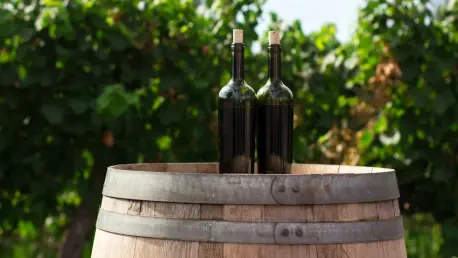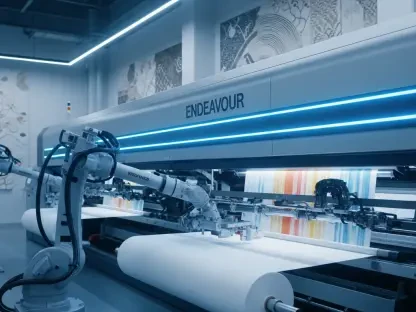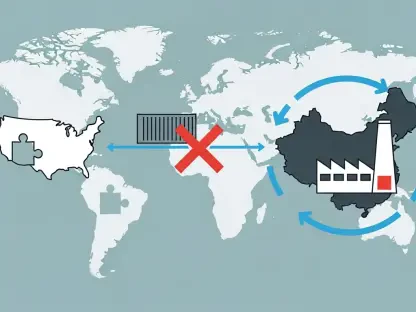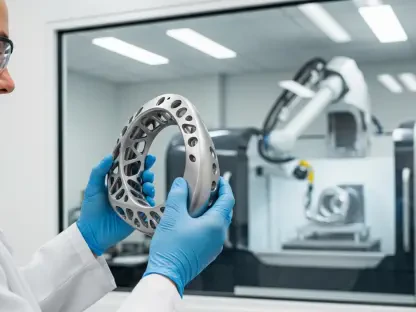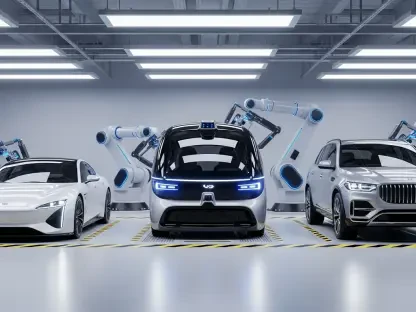In recent years, the Australian wine industry has been grappling with a significant challenge—how to reduce its environmental impact while maintaining the quality and tradition for which it is renowned. The battle against carbon emissions within this sector primarily focuses on the heavy glass bottles traditionally used for wine storage, which contribute substantially to the carbon footprint due to their production and transportation. Recognizing this, the Australian government has taken decisive action by supporting innovative packaging solutions through the Business Research and Innovation Initiative (BRII). This initiative is more than just a challenge to innovate; it acts as a beacon for the sector, guiding it towards achieving net zero emissions by 2050 and an interim target of a 42% reduction by 2030. The initiative not only focuses on the present but also sets the foundation for sustainable practices that could redefine the future of wine packaging, ensuring both environmental preservation and industry growth.
Government Support for Sustainable Packaging
The Australian government has stepped up as a pivotal force in the push for sustainability within the wine industry, highlighting the importance of innovative packaging solutions. Through the BRII, it has provided grants to six companies tasked with exploring groundbreaking packaging alternatives that prioritize environmental stewardship. This governmental backing is crucial, as it not only underscores the commitment to achieving substantial emissions reductions by 2050 but also drives the immediate goal of cutting these emissions by 42% over the next few years. Such initiatives align with broader environmental policies, aiming to redefine how wine is packaged and distributed, thereby nurturing a more sustainable industry framework. By investing in these ventures, the government supports both the research and development stages of new packaging technologies, ensuring that promising concepts receive the resources needed to evolve into practical, scalable solutions.
The strategic funding from BRII also catalyzes collaboration among startups, SMEs, and industry leaders, fostering an ecosystem where innovation thrives. These grants play a crucial role in bridging the gap between conceptual ideas and tangible outcomes, effectively propelling the industry toward a greener future. The initiative’s emphasis on sustainability is reflected in the diverse array of solutions being developed, each uniquely tailored to address the specific needs and challenges of the wine sector. From compostable polymers to advanced AI systems, the government’s involvement is instrumental in transforming these innovative ideas into viable commercial realities. This collaborative approach not only accelerates progress but also sets a global precedent, showcasing Australia’s leadership in promoting sustainable practices within the wine industry.
The Problem With Traditional Packaging
Traditional wine packaging, particularly the use of heavy glass bottles, poses a significant environmental challenge, as these bottles represent around 70% of the industry’s emissions. The manufacture and transport of glass contribute heavily to carbon emissions, given the energy-intensive processes involved in their production and the additional fuel required for transportation due to their weight. As consumer awareness of environmental issues grows, so does the demand for more sustainable solutions, prompting a reevaluation of these time-honored practices. The substantial weight of glass bottles not only impairs energy efficiency but also incurs higher transportation costs, thereby compounding their environmental impact. Moreover, traditional packaging materials often lack recyclability, exacerbating waste management issues and further burdening ecosystems.
This growing awareness has intensified the search for alternative packaging that maintains the integrity and quality synonymous with Australian wine while significantly reducing the carbon footprint of its distribution. The transition away from traditional materials involves exploring cutting-edge materials and methodologies that offer similar protective qualities for the wine but with far less environmental cost. The challenge lies not only in developing these packaging alternatives but also in overcoming any potential resistance within the industry and among consumers accustomed to the conventional glass bottle experience. Embracing the need for change, stakeholders within the wine industry are increasingly turning to innovative materials and designs to meet sustainability goals, demonstrating a commitment to not only preserving the planet but also ensuring the longevity and reputation of their products in a rapidly evolving market.
Steps Toward Innovation
The BRII has implemented a structured methodology to drive innovation in wine packaging, commencing with the identification of critical challenges within the industry. This initial phase involves government agencies pinpointing specific issues, creating a clear framework for startups and SMEs to devise targeted solutions. Once challenges are identified, the BRII provides feasibility grants of up to $100,000 to those presenting promising concepts, allowing them to explore the technical and commercial viability of their ideas over three months. This phase is crucial as it bridges the gap between theoretical innovation and practical application, providing the resources necessary to refine and validate new technologies in real-world contexts.
The final phase of BRII’s model, the proof of concept stage, grants up to $1 million to successful projects, enabling the development of prototypes that are tested for quality, durability, and environmental impact. This stage is pivotal in transforming innovative ideas into production-ready solutions that can be scaled and implemented industry-wide. By facilitating this comprehensive process, BRII not only accelerates innovation but also ensures that developed solutions are robust, effective, and capable of meeting the stringent demands of the wine industry. This strategic approach highlights a commitment to reducing dependency on traditional, high-emission packaging options and provides a blueprint for how governmental and private sectors can collaborate to effect meaningful change.
Case Studies of Grant Recipients
The companies receiving BRII grants have showcased an impressive range of creative approaches to revolutionizing wine packaging while aiming for lower emissions. One such endeavor involves utilizing compostable food-grade polymer bottles crafted from grape marc, a byproduct of winemaking, enabling the development of rigid-walled bottles that mimic traditional glass in form and function. This effort not only aligns with sustainability goals but also supports a circular economy by converting waste into a valuable resource. Another innovative pursuit by a different company involves deploying AI systems to manage defect detection in glass bottle manufacturing. By focusing on fine-tuning the quality of lighter bottles, this approach significantly cuts emissions tied to the production process and addresses the weight issue head-on.
Other recipients are working on advanced designs for recycled PET eco-flat bottles, incorporating thicker construction and features like oxygen barriers to lengthen shelf life. These innovations tackle the current limitations of PET bottles, ensuring they meet the industry’s rigorous quality standards while reducing reliance on traditional materials. Stainless steel bottles offer another path, promising dramatic emission reductions through their potential for reuse and recyclability. Projects also explore soft plastic pouches designed for compatibility with existing recycling infrastructure and PHA-based packaging that emphasizes low emissions and compostability. The diversity of these approaches underscores a shared commitment to sustainability, each project reflecting a unique aspect of the overarching challenge to reinvent wine packaging.
Exploring Different Packaging Technologies
Exploring different packaging technologies offers a compelling glimpse into the future of sustainable wine packaging. The innovative projects spearheaded by grant recipients reveal a multifaceted approach to addressing the environmental concerns posed by traditional packaging methods. Compostable polymer bottles, for example, highlight the potential for biodegradable materials to replace glass, offering similar protective qualities while significantly lowering environmental impacts. Such advancements leverage natural resources in a sustainable manner, reflecting a shift toward greener practices.
Simultaneously, the integration of AI technology into glass bottle production points to a future where precision and efficiency minimize emissions. By harnessing advanced detection capabilities, manufacturers can ensure high-quality standards using lighter, more sustainable materials. Similarly, advancements in recycled PET bottle design also underscore the potential of packaging innovations to extend beyond mere material replacement. With enhanced oxygen barriers and UV protection, these bottles promise longevity and robustness, addressing previous limitations and unlocking new possibilities for storage and transportation.
Initiatives exploring stainless steel and PHA-based options provide further examples of sectoral evolution focused on durability and eco-friendliness. Stainless steel offers a remarkable reduction in emissions through reusability, while PHA presents an eco-conscious, compostable alternative. At the same time, soft plastic pouches aim to integrate seamlessly with existing recycling systems, further promoting a cyclical approach to resource management in packaging. These initiatives collectively highlight that the path to sustainable wine packaging is not singular but varied. The focus remains on maintaining quality while drastically reducing the carbon footprint, ushering in a new era of eco-friendly innovations.
The Role of Innovation and Collaboration
In recent times, the Australian wine industry has faced the challenge of reducing its environmental footprint without compromising the renowned quality and tradition. A major contributor to this challenge is the carbon emissions linked to the production and transportation of heavy glass bottles traditionally used for wine storage. Responding to this, the Australian government has actively supported innovative packaging solutions through the Business Research and Innovation Initiative (BRII). This initiative serves as a driving force for the sector, aiming to lead it towards achieving net zero emissions by 2050, with an interim goal of a 42% reduction by 2030. BRII is not only about fostering current innovation; it’s about laying the groundwork for future sustainable practices that could transform wine packaging, aligning ecological preservation with industry advancement. This approach not only addresses immediate concerns but also secures the industry’s sustainability and growth for generations to come.
